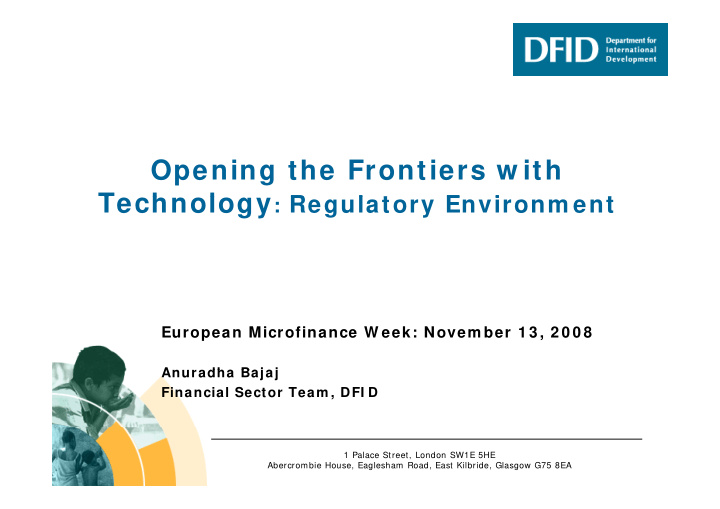



Opening the Frontiers w ith T Technology : Regulatory Environm ent h l R l t E i t European Microfinance W eek: Novem ber 1 3 , 2 0 0 8 Anuradha Bajaj Anuradha Bajaj Financial Sector Team , DFI D 1 Palace Street, London SW1E 5HE Abercrombie House, Eaglesham Road, East Kilbride, Glasgow G75 8EA
W hy is Regulation I m portant? W hy is Regulation I m portant? Regulation will determine if branchless • banking is legally permitted Which models are feasible and can they • safely deliver the financial services to safely deliver the financial services to previously un- served and underserved poor people p p p Page 1
Regulatory dom ains and risk of Regulatory dom ains and risk of coordination failure Concerns underlying prudential regulation and • supervision = only a fraction of the policy and supervision only a fraction of the policy and regulatory issues Each domain is com plex Policy-making and regulatory authority for each • domain operates more or less autonom ously domain operates more or less autonom ously from the authorities for the other domains (and regulatory concerns/ priorities may even conflict) Significant risk of coordination failure in policy • making Page 2
‘Necessary but not sufficient’ ‘Necessary but not sufficient’ preconditions W ithout addressing these issues, • transform ational branchless banking m ay never g y even start Authorization to use retail ‘agents’ ( or i) w hatever w e call them w hatever w e call them …) as the cash- ) as the cash in/ cash-out point and principal custom er interface ii) Risk-based approach for com bating m oney- laundering and terrorist financing… adapted to realities of rem ote transactions d t d t liti f t t ti conducted through agents Source : CGAP/ DFID/ GSMA Focus Note 43 Source : CGAP/ DFID/ GSMA Focus Note 43 Page 3
‘Bank-based’ versus ‘nonbank- based’ based’ ‘Bank-based’: A bank (or similar fully licensed and • supervised financial institution) is the legal provider of the financial service ‘Nonbank-based’: Customer has no legal relationship • with a bank, and instead a non-bank entity is the ith b k d i t d b k tit i th financial service provider Mobile network operator • (Also possible: non-bank issuer of prepaid cards) • W ho leads the bank based model? Not W ho leads the bank-based model? Not • • necessarily the bank… Page 4
W hat constitutes a proportionate W hat constitutes a proportionate regulatory approach? Existing regulation not drafted with convergence • of banking, payments and telecommunications in of banking, payments and telecommunications in mind Pace of change can be rapid • Proportionate regulation balances costs and • risks But policy goals are not alw ays But policy goals are not alw ays aligned, so expect trade-offs Page 5
Next generation topics to think Next generation topics to think about now Looking beyond preconditions for transformational • branchless banking: - Regulation to m itigate risk of catastrophic failure - Issues that will affect scaling up and sustainability of branchless banking I ssues: • Appropriate regulatory space for the issuance of e-m oney and • other stored-value instruments Effective consum er protection (on a variety of fronts) Eff ti t ti ( i t f f t ) • Inclusive paym ent system regulation and effective oversight as • branchless banking reaches scale Rules governing com petition among providers and promoting Rules governing com petition among providers and promoting • interoperability Source : CGAP/ DFID/ GSMA Focus Note 43 Page 6
W hat is DFI D doing in this W hat is DFI D doing in this space? Pioneering work over last two years with models • like M-Pesa in Kenya like M Pesa in Kenya New Programme FAST : Facilitating Access to New Programme FAST : Facilitating Access to • Financial Service through Technology Windsor Global Policy Forum • Using new technology enabled financial services • for social transfers Page 7
Page 8
Page 9 Thank You Thank You
Recommend
More recommend